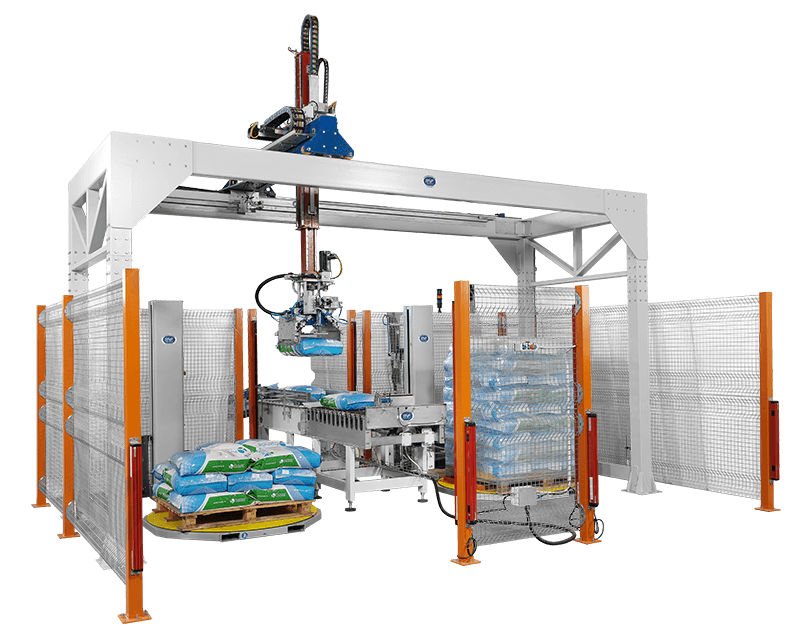Choosing the right palletiser is a key element in improving the competitiveness of your business.
Indeed, the efficiency and productivity of today's production processes also depend on the correct and effective handling of goods.
The palletiser, by handling the stacking of products on pallets, is an integral part of logistics processes.
It is one of the key technologies driving the transformation of today's production processes.
It plays a crucial role in supply-chain management and end-of-line packaging automation.
However, with a wide range of solutions available on the market, choosing the ideal model requires careful consideration.
MF TECNO has decades of experience in designing a wide range of palletisers and anthropomorphic robots.
In this guide we will help you to analyse and evaluate the factors and elements to be taken into consideration in order to find the model that is right for you.
We will analyse in particular:
- What a palletiser is and how it works
- Advantages of palletisers
- Key factors to consider when choosing a palletiser
- Different types of palletisers
- Supplier assessment
What is a palletiser and how it works
Robot palletiser is designed to automate the storage of products already packaged on pallets. It follows a predefined pattern.
It organises and stacks multiple products in a single load, making handling, storage and shipping more efficient.
It can process packages, boxes, bundles or bottles, improving general warehouse operations.
Its operation consists of receiving products and stacking them systematically on a pallet following a predefined pattern. The possibility of setting up different palletisation schemes and different types of products optimises the packaging process.
Advantages of palletisers
Automating the production process and incorporating a palletising robot into your warehouse brings many advantages
- Greater efficiency and productivity compared to manual work. Thanks to faster and more consistent work and a drastic reduction in downtime.
- Savings as a result of less use of manpower and a reduction in errors as a consequence of performing repetitive and time-consuming tasks.
- Increased safety through a reduction in work-related accidents and retraining of employees.
- Space optimisation through precise and uniform stacking systems to maximise space and reduce transport costs.
- Improved quality control and product handling.

Key factors to consider when choosing a palletiser
There are different elements to consider when choosing a palletiser.
Evaluations that lead to a preference for one model over another based not only on current production needs but also on future growth prospects.
Among the various factors to be taken into consideration are:
- Production volume and speed
- Product characteristics
- Available space
- Pallet configuration
- Safety requirements
- Investment required
- Integration with existing equipment
Production volume and speed
The palletiser must be in line with production requirements and the volume of goods produced.
Failure to meet production requirements leads to bottlenecks.
The choice must therefore take into account not only current but also future production.
Automatic palletising systems are the answer to high production requirements.
Semi-automatic or manual systems, on the other hand, are the answer to handling smaller volumes.
Product characteristics
Depending on the different product types, there are different palletiser models. The size, shape, weight and type of material are factors that influence the choice.
Products with special shapes and sizes, fragile or heavy products require customised solutions.
Available space
Available space is another element that has a major influence on the choice of palletising model.
Lack of space can limit the choice considerably. A decision that must also take into account the space required around it.
Pallet configuration
In order to facilitate the handling of goods, there are different pallet configurations. Some sectors require specific palletising and stacking configurations to maximise space and ensure productivity.
Defining the palletisation scheme that best suits your needs leads to a reduction in palletisation systems.
Safety requirements
There is also the presence of adequate safety measures and accident prevention guards to consider. For example, stop systems and sensors that can detect and prevent possible faults and accidents.
Investment required
Another determining factor in the choice of palletiser is the investment cost. In particular, the sum envisaged must take into account:
- The initial investment: Cost including the machinery, assembly and any modifications.
- Operating costs: This includes energy consumption, maintenance and labour.
- Return on investment (ROI): Overall assessment of the economic impact of the investment in the long term and not only in the short term.
Integration with existing equipment
Another decisive factor is the possibility of integrating robot palletisers with existing packaging and primary packaging systems.
This allows the entire production process to be optimised and made more efficient.

Different types of palletisers
Once the specific production requirements have been defined, the next step is to assess and analyse which type of palletiser is most suitable.
Each model in fact has characteristics that make it ideal or suitable for certain applied contexts.
Among the various types and models of MF TECNO palletisers we distinguish:
- Cartesian palletiser
- Top loading pallettiser
Cartesian palletiser
This model operates via a mechanical arm which follows vertical, horizontal and diagonal movements and around its own axis along the 4 Cartesian axes.
It is an extremely precise and high-performance option. The MF TECNO models are designed for both medium and high production rates.
Top loading palletiser
Top loading palletisers are ideal for creating stable pallets and achieving high production speeds.
Products reach the pallet forming table and the pick-up roller conveyor via a conveyor belt and bag centring belt.
Supplier assesment
Choosing the right supplier is just as important as finding the right model for you.
In particular, when searching for a palletiser company, you should evaluate:
- Experience in the sector and references
Choosing a company with proven experience and important references in the sector is certainly a key factor and an element of reliability.
Another element is the ability to provide support and dedicated customer service that is fast and accurate. Constant support both in the examination of requests and design evaluations and in after-sales assistance.
Identifying a supplier also depends on its ability to make customised installations and to meet the customer's needs and specific requirements.
We have decades of experience in the production and realisation of palletising robots. Both as individual projects and as part of complete packaging plants. Choosing us means placing your trust in a solid company that makes quality and customer focus its hallmark.
Every single component of our machinery is of our own production. This guarantees reliable and punctual customer service.
 FREE QUOTE
FREE QUOTE  Machinery
Machinery Open Mouth Bagging machines
Open Mouth Bagging machines Vertical packaging machines - VFFS
Vertical packaging machines - VFFS FREE QUOTE
FREE QUOTE 


 FREE QUOTE
FREE QUOTE 
 FREE QUOTE
FREE QUOTE 























 Request information
Request information 
